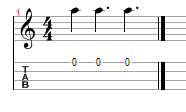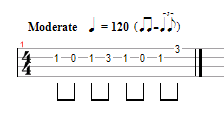Advanced Tab
Advanced Strums
Tremelo Strums
Strumming the same chord over-and-over in a regular, quick tempo is known as a tremelo strum. These can be tabbed in a couple of different ways. They can be shown in the normal way (e.g. as a set of sixteenth notes) or as the total length of all the strums together with diagonal lines underneath the note.
In this example, the first half of the bar and the second half are both played in exactly the same way. One diagonal line under the note indicates eighth notes, two lines denotes sixteenth notes and so on.
Rasgueados
Rasgueados, sometimes called rolls, are a technique that entered ukulele playing via its Portuguese roots – developing from flamenco playing.
They are produced by strumming with each finger in quick succession. You start by flicking downwards with your little finger, then ring, then middle and finally index finger. It’s important that the movement comes from the fingers rather than the wrist so you can hear each individual strum. In the example, I play through slowly (so the strums are very distinct) then up to speed.
You can learn the proper, flamenco technique from this guy’s videos.
Rasgueados are tabbed in a very similar way to usual strums. The only difference is an ‘R’ at the base of the strum.
Advanced Rhythm Tab
Dotted Notes
Often in tab you’ll see dots after the note lengths.
In standard notation these dots occur next to the circle of the note:
In tab, the dots occur next to the bottom of the line (you have to be careful as dotted quarter notes can be easily confused with eighth notes).
These dots increase the length of the note by half. For example, a dot after a half note would increase its length by quarter note i.e. it would last for three beats.
In example 9 it is a quarter note which is dotted. This means it last for a quarter note plus an eighth note.
Ties
When notes are tied together you add their lengths together. The tab for ties is an arch between the notes – the same as hammer-ons but in this case there is no note at the end of the arch.
For instance, the dotted note examples could be written with ties to create this:
Often ties will be used to show one note ringing into another.
In this example, the open A string is left ringing while the C string is played. Quite often notes will be intended to ring into each other but there will not ties in the tablature. In this case, you should listen to the performance and decide what you think sounds best.
Triplets
With triplets, three notes are played in the space of two.
They are indicated by a bracket under the notes with a 3 in the middle.
You can have any length of note in a triplet, but in this example it’s eighth notes.
A triplet of eighth notes takes up the same amount of time as two regular eighth notes i.e. one ‘pip’ in the example.
Make sure that your triplets are evenly spaced within the time.
Swing Time
When a piece has a triplet feel throughout, it is said to be in ‘swing time’. Swing time can be heard in musical styles from blues to Irish folk music to reggae. In swing time, the first half of each pair of eighth notes is played for longer than the second eighth note of the pair.
Swing time is indicated at the top left of the tab like this:
Compare this example in swing time:
To this one in straight time:
Swing time changes the length of eighth notes. The first in a pair of eighth notes now takes up the amount of time of two eighth notes in a triplet. The second eighth note in each pair now only takes up one triplet eighth note.
The technical explanation of this makes it sound more complicated to play than it is. Once you get the feel of a song, it becomes natural to play it and you’ll be able to do it without thinking about it..
.
Read the rest of the series here: How to Read Ukulele Tab.
This series was derived from my ebook Ukulele 101: 101 Things Every Ukulele Player Needs to Know.












Just when I thought I really did not need instruction reading Tab, I happened to look at your Part 4.
Mystery Solved!
I had been reading the Dotted Quarters as Eights – Guess I will start using my reading glasses a little more.
Thanks,